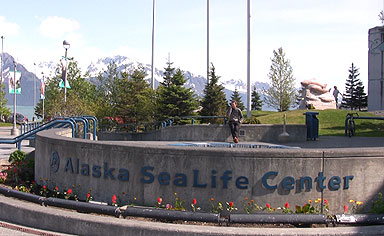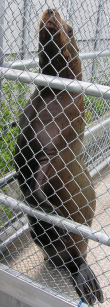The
Alaska SeaLife Center is one of
COSEE Alaska's partners, and Dr. Castellini played a major role in its creation. Castellini moved
to Alaska in 1989, two years after the Exxon Valdez spill, when there was lots of interest in
marine science on the part of the public. Mike also needed a place to do marine mammal research.
He started thinking about combining the two.
The Alaska SeaLife Center opened its doors in 1998, with Mike Castellini as the first Science
Director. It is primarily a research institution – albeit one that puts much of its research on
display. It is also the busiest marine tourist center in Alaska, with over 150,000 visitors
annually. It regularly puts scientists in direct contact with the public, training them to be
better communicators. "The public gets to see displays but they also get to interact with
scientists," says Mike.
COSEE Alaska provides links that enables the SeaLife Center to conduct a range of outreach
activities, from public lectures and demonstrations to behind-the-scenes tours. The Center
develops education materials, sponsors outreach with coastal villages (often using video
conferencing for long distance learning), and offers workshops at the annual Alaska Marine
Science Symposium.
As a research institute, it is a tremendous resource for scientists wanting to work with marine
birds and mammals. It is has a partnership with the University of Alaska, which has four faculty
on contract with the Center, and offers research opportunities to grad students (including Mike's).
It has extensive life-support capabilities for marine species from jellyfish to sea lions, and
is the major rehabilitation center for the state.
R/V Sikuliaq
The National Science Foundation (NSF) has provided funding for the building of the
R/V Sikuliaq
(an Inupiaq name meaning "young sea ice that is safe to walk on"), the first ice breaker designed
for research. Part of the NSF
University-National Oceanographic Laboratory System (UNOLS) fleet,
the ship will be operated by the University of Alaska School of Fisheries and Ocean Sciences. It
will be launched in October 2012 and will be ready for its first research cruise in early 2014.
Plans for its use are well under way, with NSF already calling for proposals. It has the capability
to go anywhere in the world, spending 300 days a year at sea, and will certainly be making trips
to the Arctic and Antarctic. Every cruise will have broader impacts components. With full
internet connectivity via satellite, students will be able to talk live with scientists. A
request for funding has been made to the State of Alaska for students and teachers to be onboard
10 days a year. COSEE Alaska will support local outreach through the SeaLife Center, and is
already talking to scientists about collaborative projects using the ship. COSEE Alaska is
also working on an exhibit in collaboration with the UAF
Museum of the North, recreating the
ship's interior to demonstrate a research cruise.





